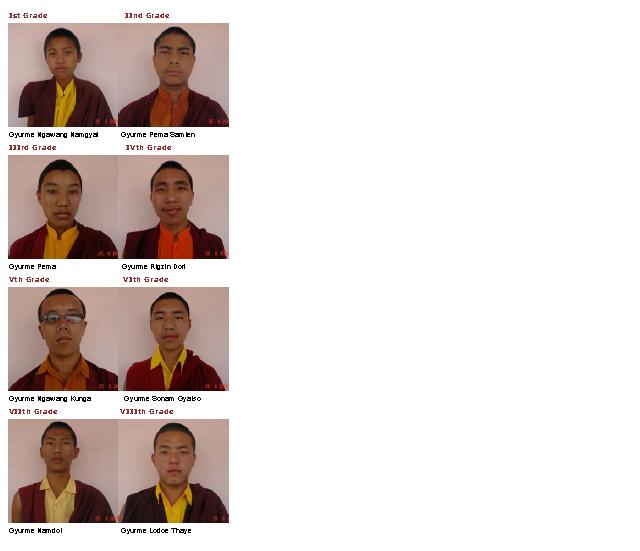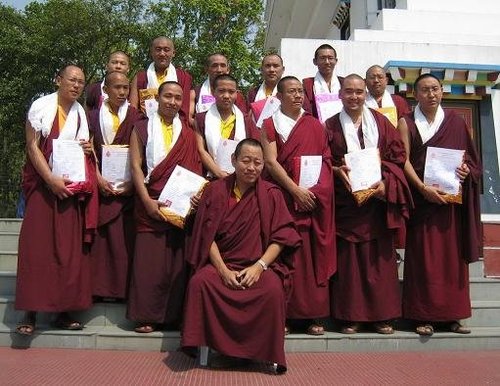
..................[敏林堪千仁波切的開示:我們必需瞭知]
佛教何以教導「無我」?
佛教是悲觀的嗎?(因為佛教強調了太多的「苦」)
佛教是悲觀的嗎?(因為佛教強調了太多的「苦」)
答案是否定的,因為這才是真諦!苦的真諦並不會令我們感覺悲觀或絕望,我們是有方法可以理解苦諦的。
我們必須能夠面對不愉快的經驗和情況,以及事物的真相;如實地面對它們。
佛教鼓勵被動式的社會嗎?
性,於密教的角色為何?
為什麼說輪迴即是涅槃?
答案是:八正道引領各別眾生從因緣變幻的輪迴中趨向並證得涅槃。
這八正道描述了我們所處的因緣條件,是什麼樣的因緣條件,以及它們帶來的問題。而我們該如何改善這些因緣條件,克服自我的不滿,再透過這八正道趨向了悟。
苦來自無常,不滿和無實質性。因此,我們需要培養以下三點:
敏銳的道德觀。這樣,我們就能夠成為一個更完美的個體,能夠克服以自我為中心的傾向,同時,也更具慈悲心,理解他人的需求。
禪修。透過禪修,我們的心變得更為專注靈敏,也因此開展出智慧來。
八正道:與智慧相應的正見和正思維
開展靈敏道德觀的正語、正業和正命
鞏固禪修定力的正精進、正念和正定
於佛教的觀念,三種苦包括:
痛苦
–
這包括戰爭、饑荒、政治迫害、不公平等等所帶來的苦;
無常苦
五陰熾盛苦
苦來自內在,來自自心。苦來自無知,不知道何為善、何為惡,不是什麼能夠產生樂,什麼又會增加不快樂和痛苦。缺乏知識、缺乏洞察力才是真正的苦因。因此,對佛教而言,創造世界的,可不是主宰的神,而是我們的心。
心主宰了我們的所有經歷,包括喜悅痛苦。我們所住的世界,也都唯心所造,是以,作為佛弟子,對於心的功能之認知時非常重要的,也因此,禪修對佛弟子而言也非常重要。
禪修對於更深入的自我認知息息相關。有許多問題的出現,都因為我們對自己的認知是不夠的;都因為我們的無明。
大乘佛教的最終目標並不是為了根除情緒,而是在認知與實效性的層面上轉念。最終,當通往驗收成果的階段,也涉及二個層面:覺悟者的心理層面和生理層面。在這條道上,透過慈悲心的修鍊,我們趨向了知覺悟者的身理層面;透過智慧的修習,我們了悟覺悟者的心理或是認知層面。
在梵文,我們稱呼未證佛果的眾生為菩薩。此一詞彙,指涉趨向證悟之道的修行者。菩薩最為重要的特性,即是慈悲。證悟,並不是靠個人的努力而有所證,而是因為與他者互動而有所證。
於大乘佛教,禪修與行動齊頭並進;若智慧不足,即談不上真正的慈悲。唯有透過真正智慧的開展,我們才會有真正的慈悲服務他者而不會偏頗。若慈悲中沒有智慧,悲心就會因自己的自私、所愁善感或是需求有所染污。
菩薩有兩種類型:一為「地上菩薩」,二為立志證悟的菩薩。
觀音菩薩:慈悲的化現。我們以觀品菩薩的聖像為所緣,觀想如何開展慈悲心。
文殊菩薩:智慧的化現。我們以文殊菩薩為觀想所緣,來開啟智慧。
大勢至菩薩:大願的化現;增長我們遵循這條道路的力量。
文殊菩薩為無明的對治(法門),觀音對治私心,而大勢至則對治焦躁不安的心。
如何成為菩薩?
~~~培養菩提心(證悟之心)。
菩提心有兩個層面:相對菩提心和究竟菩提心。
究竟菩提心:指「心」本身的特性(稱之為佛性)
相對菩提心:指對慈悲心的培養和啟發。
六波羅蜜
慷慨(佈施)佈施的精神,便是在沒有執著、期望、或是希望得到他人回報的情況下慷慨給予。
物質上的佈施,意味著我們能夠毫不猶豫地對他人伸出援手,也不對自己所擁有的一切過於執著而不願意與他人分享。這種佈施,能夠在生理層面上減輕人們的痛苦和匱乏。
無畏佈施,即是捍衛他人的生命。這意味著當別人處於危險時,我們能夠毫不猶豫地幫助他們。
法佈施:佈施的對象包括那些聞法之後能夠受用的人。
-意圖(法佈施應該持有純淨的意圖,也不能夠存有「高人一等」或「我比他有見地」的我慢心。
-法佈施的途徑
戒律:所有的波羅蜜都與戒律或是道德規範息息相關。
與防止相關:戒律禁止殺與妄語
善的聚集:這意味著不僅是防止個人趨向負面行為。
該利益的,還包括他者,而不僅是自身。
3) 忍辱。憤怒與快樂是不能同時存在的。佛教的最終目標在於滅一切苦,我們必需克服心中所升起的一切負面思維。
a. 應付對你有害的人:菩薩應該學習如何應付那些性個難易相處、好狠逞勇、嗔恨心強和煩惱心重的人。
b. 面對困難:即便我們面對種種困難,我們也不能向絕望與挫折低頭。我們必需認知到生活的困難,而這種困難只是生活的一 部分。我們不能夠認為一切都會很平順地過,也別寄望毫無努力就能夠得到一切。
c. 探尋真理:該知道一切的發生皆有其因緣。我們所面對的困境也不是永恆的,因為這些困難也有其因緣條件,也是短暫的。
4.精進。一般也被人譯為努力。精進波羅蜜是懈怠的對治。昏沉共有三類。第一類的懈怠來自自身的昏沉或對目標的漫不經心。第二類懈怠是因為散漫,總認為像我這樣的人,即便是努力修行,真能有什麼樣的成果嗎?最後一類懈怠來自掉舉,心一直處在焦躁不安,及其忙碌。
三種精進,以為這我們持續不斷地下決斷,直到我們達到目的為止,也不讓自己偏離中道。
適用於工作的精進(與生理層面相關)。一旦下了承擔的決心,我們就需要方便法門的輔助。
不滿現狀。佛陀一再強調(眾生必需)克服不平和不滿的心。
禪修分為兩種,一為定禪,以培養禪定力為主;二為觀禪,以內觀為主。
why does buddhism teach that there is " no self"?
is buddhism pessimist ( cuz it concentrates so much on suffering)Ans- No, its realistic.The truth of suffering need not make us feel pessimist and hopeless. There is a way that we can try to understand it.
We have to be able to face up to unpleasant experiences and situations, the reality of things, The facts as they are.Does buddhism encourage social passivity?
What is the role of sex in Buddhist Tantra?
why is it said that "Samsara is nirvana"?
Ans: the eightfold noble path leads the individual from the condition of samsara to the attainment of nirvana.They describe the condition we are in, what sort of conditions are prevalent and what the problems are.
They prescribe in terms of how to improve our situation, overcome our sense of dissatisfaction and
attain enlightenment through following the eightfold noble path.
Suffering comes from impermanance, dissatisfaction and insubstantiality.Developing three things in an indivadual-1) Moral sensitivity( we become better individual,able to overcome our egocentric tendencies .We become more compassionate and more sensitive to the needs of others.
2) Meditation- through the practice ot meditation our mind becomes more focused, more resilient and more aware which in turn gives wisdom.
Eightfold Noble Path- Right Understanding and right thought (correspond to the devt. of wisdom)
Right speech, Action,Livelihood (develop our moral sensitivities)
Right Effort, Mindfulness, concentration (foster our meditative capabilities)
Three kinds of sufferings in buddhist point of view:
a) suffering of pain- suffering of war, famine, political oppresion, injustice and so on.
b) suffering of change-
c) suffering of condition existence-
suffering comes from within, from the mind.The cause of suffering in ignorance-not knowing what is beneficial,and what is not beneficial, not knowing what will produce happiness and what will increase our unhappiness and suffering.
suffering comes from within, from the mind.The cause of suffering in ignorance-not knowing what is beneficial,and what is not beneficial, not knowing what will produce happiness and what will increase our unhappiness and suffering.
Lack of knowledge, lack of insight are the real cause.So for buddhist it is not god who has created the world but our mind-The mind is the one responsible for all our experiences:Joy, happiness, pain, suffering .
The world we live in is created by mind.Therfore it is very important as a buddhist to understand how the mind functions and that is why the practice of meditation is so important for buddhists.
The practice of meditation has to do with the greater understanding of ourselves.A lot of problems come about precisely because we do not understand ourselves, it is because of ignorance(avidya).
The ultimate aim of Mahayana Buddhism is not to eradicate emotions as such but to transform our mind, in both its cognitive and its effective aspects.Finally the path leads to the fruition stage,which also has two aspects.fruition aspects of the path- The mental aspects of buddha being and the physical aspects of buddha's being. Through the practice of compassion on the path, we are led to the realisation of the physical aspects of Buddha's being. Through cultivation of wisdom, we realise the mental or cognitive aspects of Buddha's being.
Before he became awakened, he is reffered to in sanskrit as Bodhisattava.The word reffered to someone who had embarked on the spiritual path and who was progressing toward enlightenment.The most important characteristic of the bodhisattava is the element of compassion. Enlightenment is not achieved individually by our own effort in a personal kind of way; rather it is achieved in relation to and in interaction with others.
In mahayana buddhism meditation and activity go hand in hand, in that we cannot really have genuine compassion without wisdom. It is only through developing proper wisdom that we will be able to have compassion and do things for others in a way that is not partial.
If wisdom is not present in compassion, compassion can become degenerated and polluted, owing to our selfishness, sentimentality, or need.
Two kinds of boddhisattava- Ideal boddhisattava and the Bodhisattava who apsires to achieve enlightenment.1) Avalokiteshvara- embodies compassion, we use the image to think about how we might develop this ideal compassion in ourselves.
2) Manjushri- embodies wisdom,by visualising and practicing manjushri we try to emulate his qualities .
3) Vajrapani- embodies the quality of will, to increase our ability to follow this path.
Manjushri becomes antidote to ignorance, Avalokiteshvara to selfishness, Vajrapani to apathy and Achala to the distracted or agitated mind.
How to become bodhisattava?
- Generate bodhichitta( Heart of enlightenment). Bodhichitta has two aspects: Relative aspects and Ultimate aspects.
ULTIMATE BODHICHITTA- refers to the nature of the mind itself(called buddha nature)
RELATIVE BODHICHITTA- refers to cultivation and generation of compassion.
SIX PARAMITAS 1) Generosity-Dana(Jinpa) The essence of generosity is giving without attachment or expectations, without thought of receiving something in return.a) Practicing generosity on the material level, means we are able to extend ourselves and not hesitate to help poeple in need and we
dont become so attached to our possesions that we cannot share them.This type of generosity works on the physical level by relieving people's
physical pain and deprivation.
b) Practicing generosity by giving protection, by protecting peoples lives.This means if others are in dangerm we do not hesitate to help
them, we do not hold back.
c) giving spiritual teachings and advice- object of generosity( person to whom the teachings are to be imparted should be interested.
- Intentions( Teachings and advice are to be given with pure intentions, not sullied by thinking I'm better or i know more.
- Way of impartin dharma
2) Moral Precepts-shila.(Tsultrim) All the paramitas are involved with ethics(rlues of conduct) or morality.a) Related to restraint- precepts against killing and lying.
b) Gathering of wholesomeness- means that it's not sufficient simply to restrain oneslef from negative forms of actions.
c) Acting to benefit others, not just oneself.
3) Patience-shanti.(zodpa) Anger and happiness cannot coexist. Ultimate aim of buddhism is to overcome suffering for which we mustovercome negative tendencies in the mind.
a) Coping with harmful people( Boddhisattava has to learn how to cope with people who have very difficult personalities, who are
aggressive, annoying and upsetting.
b) Working with difficult situation( Even when we are confronted with these, we should not yield to despair or frustration.
We need to realise that life is not easy, That difficulty is part of life;we should not think that everything will go
smoothly or fall into our laps just like that, without our making effort.
c) Investigating the whole of reality( Should know that eveerything takes place because of causes and conditions. Difficulty we
experience are not permanent cuz everything depends on causes and conditions and is transient.
4) Vigor-Virya.(Tsundu) often translated as effort.The paramita of vigor act as an antidote to laziness.There are three types of laziness.Laziness resulting from inactivity or lack of interest thinking that you can't be bothered.
Laziness comes from lack of confidence, from thinking, How could a person like me achieve anything? Even if i try it won't work.The last kind of Laziness has to do with overacting, always being busy, doing this and that.
Three types of vigor- Armorlike vigor( means that we consciously make the decision that until we attain the goal, we will not allowto be side tracked.
- Vigor of applied work( relates to our physical aspects. Having made such commitment, we need to engage in upaya, or skillful means.
Discontentedness( Buddhism frequetly speaks of overcoming dissatisfaction and discontenment.
Link between wisdom and compassion- Through developing our morality we can arouse compassion and through meditation we are able to cultivate insight or wisdom.If a practioner engages in meditation and develops wisdom but is unable to develop compassion, a problem arises. Through wisdom we may be able to understand the nature of the self and to have a certain understanding of reality, but without compassion we are unable to in the world and interact with other living beings. Similarly, compassion without wisdom may enable us to interact other living beings, but our lack of wisdom causes that interaction to become polluted with defilements, delusions and illusions.The paramita of meditation is the link between wisdom and compassion.Meditation is SAMADHI/DHYANA meaning samten in Tibetan which means stable mind.In buddhism meditation refers to undistracted mind which is able to focus on the object of meditation.
Meditation is of two types- Meditation of tranquility(shini) meaning dwelling in peace and Insight meditation(lhakthong) meaning superior seeing.
Nine posture: Cross-legged position, hand resting one on the other in the lap/knees,shoulder slightly stretched, head slightly inclined forward,
spine absolutely straight, gaze directed downward and concentrating on the tip of the nose, mouth slightly open, the tip of the toungue touching the roof of the mouth and breathing even and relaxed.Then the meditator shoud focus his/her mind on the breath/use other objects of concentration, such as image of the Buddha.
Five Obstacles to meditation- Laziness, forgetfulness,drowsiness,mental agitation,non-application, over application.
Eight antidotes to meditation- conviction, inclination, exertion/vigor and pliancy of body and mind, Mindfulness, awareness,application, equanimitY.
◎延伸閱讀 :溫故知新•
您可以瞭解更多~~
【敏卓林堪千世系~~首座輔弼大譯師
羅千達瑪師利尊者
略傳
http://tw.myblog.yahoo.com/theeasternsun-khenchen/article?mid=557&prev=634&next=548&l=f&fid=18
敏卓林•怙主堪千仁波切開示~ ~caring for each other 】
http://tw.myblog.yahoo.com/theeasternsun-khenchen/article?mid=2145&prev=2218&next=2135
【敏卓林•怙主堪千仁波切開示~ ~母親 &度母 ~~】
http://tw.myblog.yahoo.com/theeasternsun-khenchen/article?mid=2336&prev=-1&next=2329
【敏卓林•怙主堪千仁波切開示~ ~無常&心】
http://tw.myblog.yahoo.com/theeasternsun-khenchen/article?mid=2345&prev=-1&next=2336
◎版權所有•
懇請尊重智慧財產權。如欲轉貼引用,
敬請連結敏林堪千仁波切唯一中文官網:【敏林堪千仁波切的達瑪師利語自在秘密宮殿】( The Eastern Sun Group•敏卓林佛學院編輯團隊),謝謝!
2009年 6月敏卓林小學和中學部榮譽榜:
每年的考試成績,決定學生的成績名次,這些學生是為各自級組的第一列順位
~~ 佛門來日碩彥,
願您們百尺竿頭 更進一步!
 此主題相關圖片如下:
此主題相關圖片如下:
 此主題相關圖片如下:
此主題相關圖片如下:








